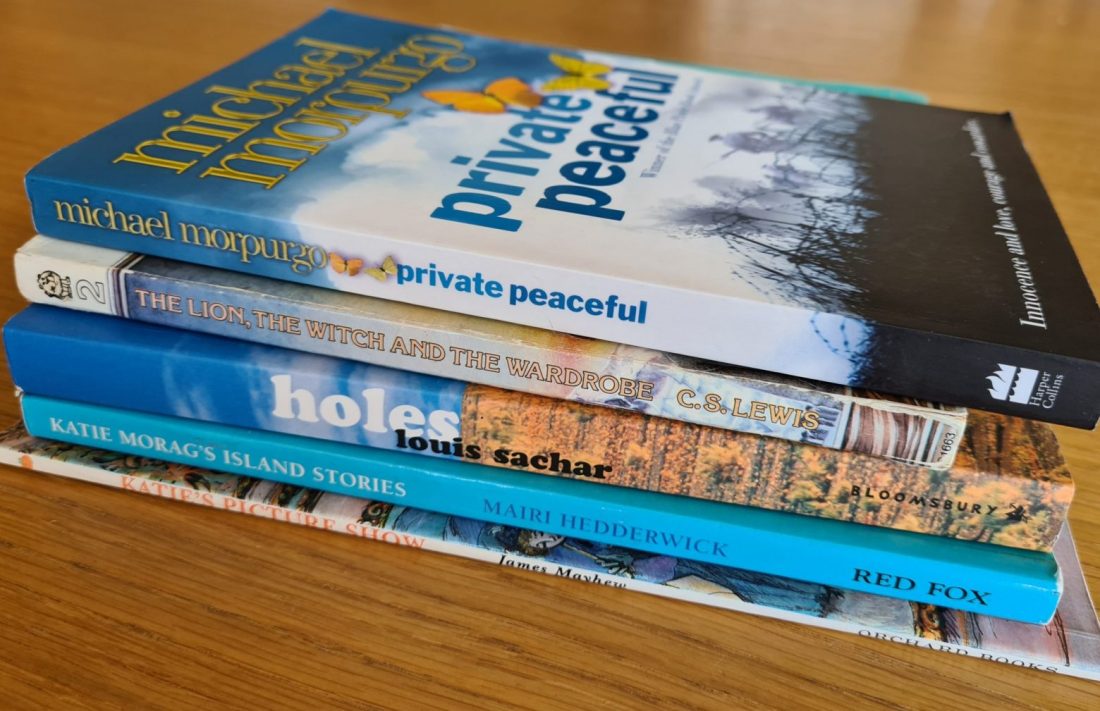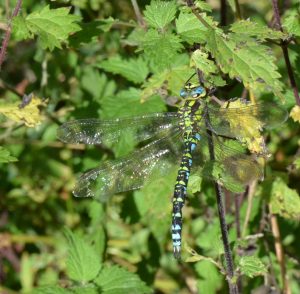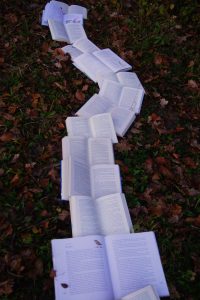
November 20, 2023, by Rupert Knight
My science teacher is telling tales
In this post, Jane Morris, from the University of Cumbria considers the potential contribution of a storytelling approach to science teaching.
Doris Stickley’s thoughtful book “Water Bugs and Dragonflies” tells the story of a small colony of water bugs living happily below the surface of a quiet pond. Every so often one of them climbs up a lily stalk and disappears from sight, never to return. Those left behind are faced with the mystery of figuring out what has become of them.
This tale contains all the elements of a good drama. It has a beginning where the context is described and the nature of the status quo. It then highlights the trigger point of a disruption of imbalance which causes our water bug to question, “what’s happening, where are they going?”. The middle of the narrative describes the events that arise as a result of the waterbug’s action of climbing the pond leaf and the outcome of this. The end brings a revelation (Moon, J. 2010).

The process of good storytelling should arouse curiosity, create tension and provide a satisfaction of answered questions and an interesting resolution (Loxley et al, 2017). This particular story, whilst a lovely start to consider life cycles, has also been used with children to help explain death and it is a tale I shared at my mother’s funeral as I grappled with her early passing. Over twenty years later I met up with an acquaintance who had been at that event. She told me she had never forgotten the story, bought a copy and had shared it many times with her own children when they had to deal with loss. On many fronts, this particular narrative explains very little about death. The strength of the story, for me, is how it touches simply on the changes associated with life cycles and, in this case, uses it to sponsor hope in tough times. I’m reminded of its message each time I see a dragonfly!
Why have I recalled this? Why is it memorable to me?
In storytelling, listeners engage with their intellect and emotion; a coherent narrative engages the emotion and helps the listeners respond to the facts (Martinez-Conde et al. 2019).
One prominent hypothesis that may, in part, explain this, is transportation theory. Transportation theory suggests that narrative processing can make individuals feel as if they are immersed in the world of a story. Being immersed then causes people to react emotionally in a way that is similar to how they react to real-life events. This is thought to make the listener/reader more likely to be persuaded of the story’s message (Vaccaro et al 2021). Intriguingly, when individuals are in an affective state that matches the emotional tone of the story they are about to experience, the reported feeling of transportation increases (Green et al., 2012). Grief does indeed bring a substantial set of emotions which, for me, matched the tone of “Waterbugs and Dragonflies” beautifully and I can indeed recall not just an almost literal immersion into the storyline but can still retell the story with ease.
This influence of narrative has been also used to actively reshape perceptions and behaviour and “facilitate persuasion where individuals’ beliefs are typically resistant to change, such as in regard to health-related behaviors (sic), intergroup prejudice and prosocial decision-making” (Vaccaro et al 2021). comments on a U.S. alternative sentencing program, Changing Lives Through Literature (CLTL), which has turned such research into practice. Eight men discussed different books with University of Massachusett’s Professor Waxler that included Jack London’s Sea-Wolf and James Dickey’s Deliverance; books about male identity and friendship, the struggle against authority, and the longing for recognition. Many of the prisoners identified with the characters’ stories, the motives and struggles of these characters helped them make better decisions in their own lives and their own voice. In a study of 600 people who participated in the program, rates of criminal activity dropped by 60 per cent — compared to only 16 per cent of a control group.
How do these story examples link to science teaching?
We are narrative creatures. We humans compile and share our own experiences via story, and our tales express concepts, actions and values through the construction of “possible worlds” (Bruner, 1986). Bruner suggests that human beings organise experience and memory in the form of narrative (Kerby et al., 2018). He develops this further with the ontological problem of the nature of narratives: are they real or imaginary? Revel Chion and Adúriz-Bravo consider Bruner’s suggestion that tales are our own creation, invariably using aspects of the real world, but aiming at different purposes such as building suspense and intrigue, reporting our view on events, imagining what we would like to happen, proposing different endings for stories that already have one or highlighting the moral aspects.
The tales we tell therefore mimic aspects of real-life (Cormick, 2019) and are the method by which we coordinate time, represent embodied action, promote social collaboration (Armstrong, 2020) and make meaning (Fuchs, 2015).
Another idea, narrative theory suggests the brain operates in narrative structures—short or long, simple or complex. We edit what we share, removing/extending sections, in order to remember what is relevant. Through this process, stories help us remember more information, reduce counter arguments, keep us engaged, are more convincing than just data and provide a vicarious experience (Cormick, 2019). Narrative is even more engaging when it has social relevance; we are motivated by resolution of the tale (Downs, 2014).
With these notions in mind, can story be used to help overcome one of the challenges in science education? Providing information as facts and figures, even in accessible and inclusive form, is not always the best way of educating an audience (NASEM 2017). And information that sits at odds with a personal belief or philosophy is unlikely to be absorbed either (Oliver and Cairney, 2019).

What could this look like in practice?
Nicola Kitchen, a colleague in the Institute of Education, Arts and Society at the University of Cumbria, leads on the science teaching with our undergraduate and postgraduate student teachers and has adapted the 5Es approach to planning from the US to involve a strong narrative flavour. She explains the impact of her story sessions in the classroom.
“The Materials and the Properties aspects of the science curriculum can be dull and, more seriously, have little to link the learning to a context external to the classroom. A narrative can make explicit the enquiry and problem-solving aspects of science, showing clearly how science helps explain our world and find uses for the new knowledge generated.
A student working in Upper Key Stage 2 in a challenging area, with a class who saw little to engage them with school, was asked to teach physical changes of state and irreversible reactions. With the help of the school secretary and some props, the children and their classroom were requisitioned by the Government to become the sort of set up we see in James Bond films. The secretary would bring a securely padlocked case covered with “Top Secret” stickers, telling the class it had been delivered by special courier. The case contents would outline the problem spies were having trying to hide and recover substances behind enemy lines and useful equipment. At the end of the lesson the written reports the class had generated would be securely locked inside ready for the courier to collect it.
The student’s target was to develop teaching strategies which promoted children’s autonomy in science, and it worked like a dream. She told me that she never had to explain or demonstrate anything. Even though the children knew perfectly well it wasn’t true (if a spy is in trouble overseas, MI6 does not ask primary school children to sort it out!), they threw themselves into it – even the report writing. This was a class where asking them to write anything was normally a lesson in futility. Each morning the children would plague the student teacher asking if she had heard back from the Government yet and what had they thought of their reports. The class teacher told her she had never seen her class work like that on anything before.”
I think, if we used Avraamidou & Osborne’s (2009) summary of the benefits of storytelling as a checklist against the student’s lesson, all the boxes would be ticked:
-
increasing interest, engagement, and motivation for learning;
-
providing a context or example for learning concepts;
-
building models to explain the natural world;
-
making learning more memorable;
-
teaching about science as a human enterprise, thereby humanising scientific knowledge;
-
introducing scientific inquiry and
-
integrating science and literature.
And, just as importantly, the student created an inclusive event that benefited their culture, place and context that were presenting an educational challenge.
What does a story therefore need to teach a science concept?
-
Bruner (1991) states that the most important property of narratives for educational purposes is that they are inherently sequential: narrative texts are constituted of a temporally arranged succession of facts, events, actions, results and the related mental states. This sequentiality appears to be the help recipients need to maintain interest in the text, comprehending and memorising the storyline. The structure also activates in the audience a wish to solve an unbalance originated in (or rather, by) the story (Lodge, 1986).
-
Intention. Any story constructed for science teaching should have a clear narrative intention: informing, convincing, alluding, deceiving, influencing, conditioning, scaring, etc. (Revel Chion and Adúriz-Bravo, 2022)
-
Stories need to relate to the familiar if Waxler’s research with inmates is to be followed. The personal narrative detail that sits in the novels chosen by Waxler is one of the most powerful forms of communication that exists. This is because stories, and in particular personal stories, “have the ability to illuminate fault lines, highlight oddities, and paint a picture of the past, present, and future that is both compelling and easily understandable” (Suzuki et al., 2018). Providing contexts that children can identify with not only supports the desired emotional engagement but also reduces cognitive load (Ali, Marcus and Sweller, 2021).
-
Catherine Gripton and Helen J Williams refer to story and maths teaching in their blog in this series “Harnessing the power of story to promote mathematical learning” and highlight how story can foster authentic mathematics learning. One approach is, instead of starting with the curriculum, and finding a story to match the maths focus, you start with a story. As with Nicola’s examples in science, the story then leads the maths. The rich fictional world of a story provides a ‘hook’ and whilst the story may be fiction and not based on real world experiences, if it is ‘real’ to the students then the authenticity effect is the same. As Catherine and Helen conclude, “The narratives bring mathematics alive for children and are as authentic as any ‘real world’ problem”.
-
Composing stories that are compelling and effective at teaching science is a difficult process, with no prescribed way to generate a good tale (Bruner, 1986). Klassen (2010) called for the development of a new form of story for teaching science concepts, stating, ‘In the context of learning science with the utilization of stories, the story needs to be re-invented to make productive use of this enduring method’. The suggestion is therefore made to apply the principles of playwriting and embed the conceptual learning into the struggle of the protagonist, ensuring your audience is the protagonist! The dramatic question around the character – the essence of any tale – is removed because a listener’s involvement and engagement with the character gets in the way of science concept learning. So, instead, a dramatic question is set up that involved a predictive question – which ball will bounce higher? Readers of the story become the protagonists; becoming the strugglers with and solvers of the problem.
All of which brings me back to Nicola’s example above with the Y5/6 spy helpers and another very clever scenario with Y3/4 who had human variation and measuring as their term topic. Nicola takes up the tale:
“A student on his Extending placement was given the topic of human growth and variation to teach. The school followed a scheme, and the suggested lesson involved the children measuring and comparing body parts. This activity can create a lot of “busy-ness” but again can lack context and real-life purpose. Inspired by a University session he had taken part in, he created both with a clever use of a familiar story.
During a lesson the student teacher’s PowerPoint was hacked into. The Giant from Jack and the Beanstalk had been burgled again, but this time he had some clues left by the thief. He had been able to collect data including from hand and footprints and from how high up the thief had been able to reach. The Giant was very angry and was sure the thief was in the class. The children set about gathering the evidence they needed to prove that the data the Giant had gathered wasn’t a match for anyone in the class – Fee Fi Fo Fum disaster was luckily averted.”
Conclusion
The value of scientific knowledge resides in its power to transform the way we see and impact the world and our place in it. By offering a learning environment which fosters emotional engagement, curiosity, a scientific puzzle to solve and an active involvement, we can provide children with an understanding of how science is used to change lives, a voice to share their perspectives and an associated opportunity for their own agency in this process.
Even if it is just a tale about a dragonfly.

References:
Armstrong, P.B. (2020). Stories and the Brain: The Neuroscience of Narrative. Baltimore: Johns Hopkins University Press.
Avraamidou, L., & Osborne, J. (2009). The role of narrative in communicating science. International Journal of Science Education, 31(12), pp.1683–1707. doi: 10.1080/09500690802380695)
Bruner, J. (1986). Two modes of thought. In Actual minds, possible worlds (pp. 11–43). Cambridge,MA: Harvard University Press.
Fuchs, H. U. (2015). From stories to scientific models and back: Narrative framing in modern macroscopic physics. International Journal of Science Education, 37, pp.934–957. doi: 10.1080/09500693.2015.1025311 [Taylor & Francis Online]
Kerby, H.W., DeKorver, B.K. and Cantor, J. (2018). ‘Fusion Story Form: a novel, hybrid form of story that promotes and assesses concept learning’, International journal of science education, 40(14), pp. 1774–1794. Available at: https://doi.org/10.1080/09500693.2018.1512172.
Lodge, D. (1986). Narration with words. In H. Barlow, C. Blakemore, & M. Weston-Smith (Eds.), Images and understanding (pp. 141–153). Cambridge University Press.
Moon, J. (2010). Using story: In higher education and professional development (1st ed.). New York, NY: Routledge.
National Academies of Sciences, Engineering and Medicine (2017). Communicating science effectively: a research agenda. Washington, DC: National Academies
Waxler, R. P. (2008). Changing Lives through Literature, PMLA, 123(3), pp. 678–683. doi: 10.1632/pmla.2008.123.3.678.
No comments yet, fill out a comment to be the first

Leave a Reply